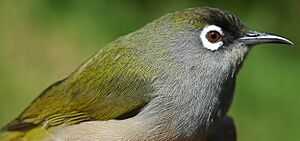Réunion olive white-eye facts for kids
Quick facts for kids Réunion olive white-eye |
|
|---|---|
 |
|
| Conservation status | |
| Scientific classification | |
| Genus: |
Zosterops
|
| Species: |
olivaceus
|
| Synonyms | |
|
Certhia olivacea Linnaeus, 1766 |
|
The Réunion olive white-eye (Zosterops olivaceus) is a small, active bird found only on Réunion Island. It's part of the white-eye bird family. This bird loves living in forests and high-up grassy areas.
Contents
What Does It Look Like?
This bird gets its name from its colors! It has an olive-green back and a bright yellow rump (the area above its tail). Its belly is gray, and its head is black. A cool feature is the circle of white feathers around its eye, which makes it look like it's wearing tiny glasses! Both male and female birds look exactly the same.
Where Does It Live?
This bird lives on Réunion Island, usually at heights between 500 and 2,500 meters (about 1,600 to 8,200 feet) above sea level. You can often spot it in the Réunion National Park or in the Bélouve forest. It especially likes places where the yellow flowers of the Hypericum lanceolatum tree grow. Its thin, slightly curved beak is perfect for reaching the sweet nectar inside flowers.
How Does It Behave?
The Réunion olive white-eye is always on the move, flitting from branch to branch. These birds can be a bit feisty! They don't always like other birds of their own kind nearby and can sometimes act aggressively towards them.
What Does It Eat?
This green bird mainly drinks nectar from flowers. But it also enjoys eating fruit pulp and small insects. It uses its special beak to get to the tasty nectar.
Reproduction and Life Cycle
Réunion olive white-eyes usually breed from June or July until January. The female bird lays 2 to 3 eggs in a nest shaped like a cup. This nest is carefully built from twigs, soft down, and moss. What's really interesting is that sometimes several pairs of these birds might share the same nest! They take turns sitting on each other's eggs to help them hatch.
See Also
- List of birds of Réunion
- Endemic fauna of Reunion Island


